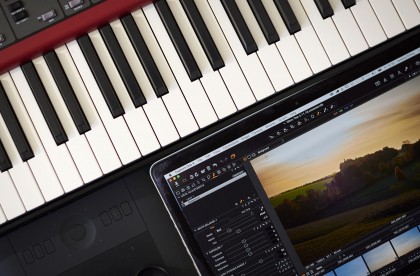
Uncategorized
What piano playing has taught me about retouching
Six Piano Lessons for Photo Retouchers
I have been working as a retoucher for over fifteen years now. While this may seem like a long time my piano playing goes back much further. It has never been a full time profession for me, but never the less it is one of my passions.
If anyone’s interested they can find just a few clips of me on YouTube.
A few decades of playing music has taught me a lot about how to improve, make efficient use of learning time, keep an audience engaged and stay motivated. I believe a lot of these principles are universal and I have applied them when retouching.
So here are six ideas I use when learning piano and how they are useful in retouching.
Performance
When learning a piece of music for performance it is there to be judged by an audience. Making the best possible impression is what helps give a piano player a good reputation. Being put under this level of pressure regularly, improves their level of musicianship and gives them confidence.
When retouching, your audience is your client. You need regular work or employment as a retoucher, being put under pressure to achieve deadlines while maintaining a high standard. This helps to make you a fast, efficient and confident artist with a reputation for quality and reliability.
Practice
If a musician only picks up their instrument for a performance they are very unlikely to change their repertoire. Playing the same music will soon get boring for both them and their audience.
Previously I worked for a small company as a retoucher where eight hours a day needed to be spent rushing through work, meeting deadlines and answering emails and phone calls. While I recognise that this helped to make me a fast and efficient worker, it also prevented me from expanding my “repertoire”. Software updates and new Photoshop plugins meant there were faster and more efficient ways of working. While I may have been aware of some of these new developments I hadn’t had time to become familiar with them and so relied on my out-dated methods through habit.
Embrace the Unfamiliar until it isn’t.
A common mistake Musicians make is to practice material and styles they are most familiar with. It is far more beneficial if they diversify. This may lead them to exciting new paths to follow or, as is more common it will add depth to their chosen style.
In the retouching world diversifying may mean learning several ways to tackle the same problem or learning to use new software. This allows you to choose the best method for any given problem. However, this doesn’t truly become a choice until the new method is as familiar as the old.
Repetition is key.
A piano player may sit at home and run through a piece of music they want to learn. They may go through it several times and memorise it. The moment comes when they get a chance to play infront of an audience and prove themselves. They get several bars in and what’s sounded great in rehearsal is suddenly full of mistakes.
Stage fright plays a large part here, but I’d like to focus on another reason for this happening. When learning something new it is common for a pianist to run over the same music several times until they can play it without mistakes. This seems perfectly logical until we take a closer look and analyse what they have done. Very often they have played the music badly dozens of times and only got it right the last one or two times. It’s no surprise that mistakes are made as these have become the stronger habit. Therefore repetition is vital, but it is more repetition than most expect.
Retouchers who are just starting out may follow a video tutorial step by step and then feel they can offer what they have learnt as a service to clients. Often what separates amateurs from professionals, is that the professionals have repeated certain methods thousands of times, until they have become second nature. When put under the pressure of time constraints on a job, retouchers can’t be referring to online tutorials.
So, if you want to offer a new service that you are unfamiliar with by all means follow online tutorials, there are a lot of great ones out there. Go over them several times then try to copy the methods without referring back to the tutorials and do that several times.
Understand what you do.
Music follows certain rules and structures. When these are understood the learning process is quicker, easier to memorise and gives an idea of possible alternatives vital to developing an individual style.
For retouchers, seeing the logic in what they are doing allows for adaptation of ideas to suit different circumstances. Also when following online tutorials it makes the learning process quicker.
Don’t ever just follow a sequence of steps blindly. Make sure you understand what you are doing and why.
A good tutorial should explain this.
Practice the Minimum.
There’s a quote from the great jazz pianist, Bill Evans, “I practice the minimum”. I remember this one because on first reading it seemed very unusual to me. This line was a response to the question “What do you practice?” rather than how much. The point being made here is that a musician should concentrate their efforts on learning fewer musical ideas over a given period of time. This gives a deeper understanding and results in ideas being retained in the memory more permanently, rather than being learnt one week and forgotten the next.
This is very good advice when learning anything. In the context of image manipulation software such as Photoshop there seems to be an almost limitless amount of ideas on how to use it. The temptation is to move quickly through as many ideas as possible without fully understanding any of them.
So yes, diversify, but be patient, take it at a pace that allows ideas to be fully absorbed. In the busy world we work in it may seem counter intuitive to slow the rate of learning, but it is a real time saver if you don’t have to keep referring to tutorials to jog your memory.
Specialise or not?
There may seem to be a conflict of ideas in this post. As a retoucher, should you specialise or diversify?
The majority of retouchers are capable of achieving very good results in a variety of styles and are unlikely to turn down what work comes their way.
A few are lucky and fit into a niche often working with a few select photographers over a long period of time. I believe the truly exceptional work comes from those that have developed their own individual style within that niche, often as a collaboration with the photographer.
I have observed some very talented retouchers working very much on the artistic side of things within their niche. One thing that is very striking is, they often can’t answer questions about using alternative methods. This is because they have developed a personal style over the years and focused their attention very much within that style.
The path that leads to this has to come from an understanding of many different ways of working. After all, you can’t narrow your focus if you already have a narrow focus to start with.



